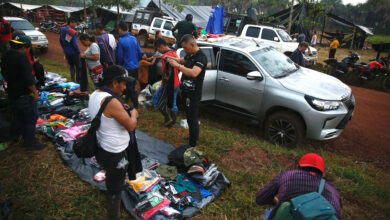Thousands of Haitians seek refuge from urban warfare in capital

By Milo Milfort
Carrefour, Haiti, Jun 16 (EFE).- For at least two weeks, more than 1,500 people have been living in a Haitian gym packed to overflowing since an urban war broke out between two gangs for control of the neighborhoods of Martissant and Fontamara, at the southern entrance to Port-au-Prince.
As the days go by, the number of displaced people increases. Babies, children, young people, adults, the elderly and pregnant women spend their days on the floor of Carrefour Sports Center, which hosts the largest group of the nearly 10,000 people who have fled their homes in two weeks of conflict in the capital.
About 60 percent of the displaced wear a mask, but physical distancing is a luxury there, at a time of surging coronavirus infections in the country.
Dynold Morose, 39, lived at Martissant 23 with his daughter and his wife. Disabled, he was saved by local residents who carried him out of the area.
“I left my house to take refuge here. Loud shots rang out, we could no longer stay. We realized that our lives were in danger. We had to flee,” he told EFE.
Now, Morose occupies a corner of the gym, not far from some family members who support him and give him his food when delivery time arrives.
The municipality of Carrefour is in charge of caring for the displaced, who have also received help from other national and international organizations such as Civil Protection, the World Food Program, the Red Cross and Unicef.
“We welcome them as best we can. You can see that conditions are not good. We must be honest,” acknowledges the mayor of Carrefour, Jude Edouard Pierre.
The number of displaced people in the gym has gone from 562 on June 6 to about 1,500, and the mayor fears that the influx of people will continue to increase.
“With the resurgence of violence in Martissant, we are concerned about new waves of displaced people as long as we do not have more capacity to accommodate them. We are reaching our limit. Today, we are overwhelmed. At the height of the pandemic, security measures are not respected,” warns the mayor.
The approximately 400 families who live in the space in early June fled from the bloody war that pitted the Grand Ravine armed group with that of Ti Bois, fighting for control of Fontamara and Martissant, neighborhoods that have been emptied of their residents.
From the National Highway 2 the desolation in Fontamara and Martissant is visible. The districts are deserted, tons of garbage litters the street, vehicles and motorcycles speed to avoid having to stop.
Schools, houses and shops are abandoned. At certain intervals, automatic weapons are heard in the region and rumors circulate that the armed gangs will try regain their lost territories.
The United Nations Office for the Coordination of Humanitarian Affairs (OCHA) estimates that 10,000 people have fled their homes in Martissant and Fontamara, as well as in the neighborhoods of Delmas and Saint Martin, the latter in the center of the capital, due to the gang conflicts.
It is estimated that at least 5,100 people have sought refuge in the homes of relatives, while hundreds of people continue to sleep in the streets and squares of Port-au-Prince or in churches, in addition to the 1,500 housed in the Carrefour gym.
In the clashes for control of the neighborhoods, there have been numerous fires of homes and businesses, attacks on civilians and sexual assaults, while the National Police appears not to have tried to stop the violence between the gangs. EFE
mm/tw





